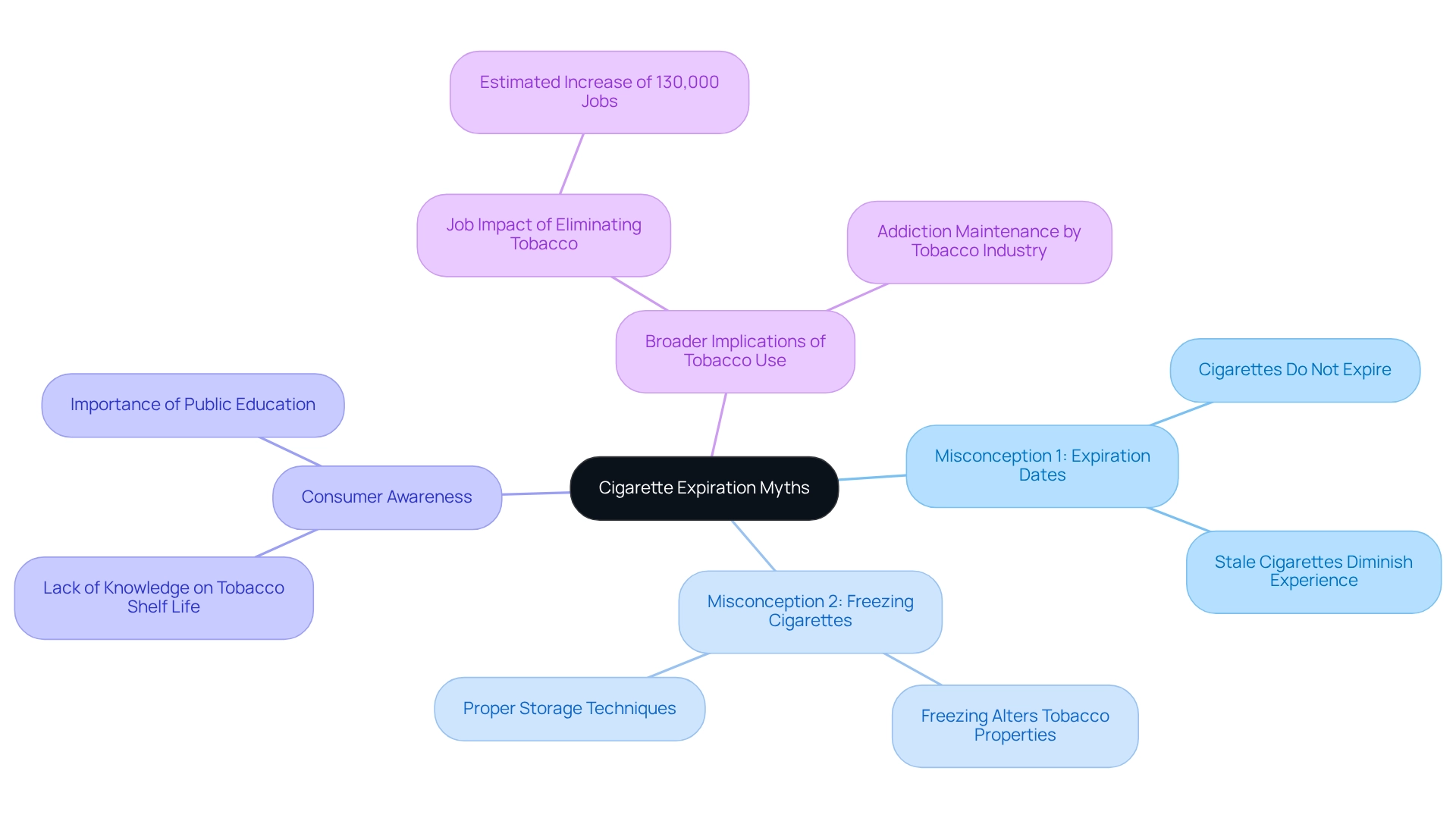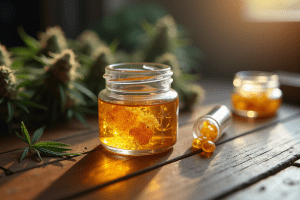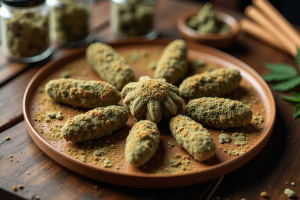Overview
Cigarettes don’t have a strict expiration date, but they can lose their freshness and flavor over time. This can significantly impact your smoking experience. Have you ever noticed a difference in taste? Proper storage is key to preserving the quality of your cigarettes.
- Maintaining a cool, dark environment
- Using airtight containers
can help prevent degradation. When cigarettes go stale, they may pose potential health risks, which is something we all want to avoid.
By taking care of how you store your cigarettes, you can ensure a better experience. Remember, we all deserve to enjoy our choices in the best possible way. Let’s make informed decisions together, prioritizing our health and well-being.
Introduction
In the intricate world of tobacco products, understanding cigarette freshness and shelf life is essential for smokers who want to enjoy the best experience possible. Have you ever wondered why some cigarettes taste better than others? Unlike perishable goods, cigarettes don’t come with a definitive expiration date, yet their quality can diminish over time, impacting flavor and enjoyment.
Factors such as:
- Storage conditions
- Packaging integrity
play a crucial role in maintaining the integrity of these products. As the tobacco industry navigates regulatory compliance and consumer safety, it’s increasingly important for us to be informed about how to preserve our cigarettes effectively.
By exploring the nuances of:
- Cigarette storage
- Freshness indicators
- Common misconceptions
we can empower ourselves with the knowledge necessary to make informed choices. Together, let’s ensure a satisfying smoking experience.
Understanding Cigarette Expiration: An Overview
Cigarettes do not have a traditional expiration date like perishable food items, which often leads to the question: do cigarettes expire? Understanding this is crucial, as the shelf life of tobacco significantly influences both its quality and the overall smoking experience. While tobacco products can remain usable for a long time, they may gradually lose their freshness and flavor—elements that are essential for smokers who wish to enjoy the best product possible.
Several factors contribute to the longevity of tobacco products, with storage conditions and packaging integrity being the most important. For instance, a study on the stability of 1R6F certified reference products showed that those stored at -20 °C retained their key constituents over three years. This highlights how vital temperature control is in maintaining quality. On the other hand, unfavorable conditions can accelerate the degradation of flavor and aroma, resulting in a stale smoking experience.
Recent discussions in the tobacco sector emphasize the importance of adhering to regulations concerning expiration dates and quality standards. Experts warn that consuming tobacco products past their optimal freshness may not only lead to a less enjoyable taste but could also pose health risks due to a potential increase in toxic constituents. As José Ignacio de Granda-Orive notes, “It is important that the tobacco industry comply with the regulations on ED and PCD because if they are consumed with those expired dates, the tobacco still would be more toxic and must be withdrawn from sale to the public.”
Additionally, it has been observed that nicotine degradation products did not exceed 2% of the nicotine content in most samples examined. This suggests that appropriate handling methods are essential for ensuring product safety.
In summary, understanding whether cigarettes expire is vital for consumers. By recognizing how storage conditions impact cigarette quality, we can make informed choices that enhance our enjoyment and safety. Furthermore, the U.S. Food & Drug Administration (FDA) has published draft guidance on premarket tobacco item applications, emphasizing the need for the tobacco industry to adhere to regulations that ensure quality and consumer safety. Together, we can navigate these choices with confidence.
Factors Affecting Cigarette Shelf Life: Storage and Environment
The shelf life of marijuana products is influenced by several critical factors, including temperature, humidity, and exposure to air. For optimal preservation, it’s essential to store the plant in a cool, dry environment, shielded from direct sunlight and heat sources. High humidity levels can encourage mold development, while excessively low humidity can lead to the plant drying out, resulting in a harsh smoking experience.
Once a package is opened, exposure to air speeds up the staling process, reducing the quality of the product. Have you ever noticed how your favorite strain loses its charm too quickly?
To address these concerns, utilizing appropriate preservation methods is crucial. Using airtight containers can significantly extend the freshness of the product by minimizing air exposure. Furthermore, maintaining optimal humidity levels is vital; research shows that non-essential minerals, like cadmium and lead, diminish in concentration during preservation, highlighting the importance of regulated conditions.
Expert guidance indicates that monitoring both temperature and humidity is essential for maintaining the quality of the plant. For instance, incorporating sensors to monitor these environmental factors can lead to better management of preservation conditions. This approach has been shown to be effective in case studies concerning tobacco curing processes. As Mr. Hssan Mejri, a Technical Assistant, expressed, “We would like to thank all the team of this laboratory and in particularly Mr. Hssan Mejri for his technical assistance with Gas chromatography analysis.”
By understanding and implementing these storage strategies, we can ensure that our items stay fresh and enjoyable for as long as possible. Together, let’s make informed choices that enhance our experience.
Identifying Freshness: How to Tell If Your Cigarettes Are Still Good
When evaluating the freshness of marijuana products, it’s important for us to be attentive to several key indicators. Fresh marijuana typically has a pleasant aroma, vibrant color, and a slightly sticky texture, all of which signify quality and moisture. On the other hand, stale marijuana often appears dry, dull, and gives off an unpleasant smell, which can really detract from our experience.
Have you ever noticed that stale marijuana can also produce a harsher taste and burn unevenly? This can make our enjoyment of the product significantly less satisfying.
Research shows that the sensory characteristics of marijuana, such as aroma and texture, play a vital role in determining freshness. For instance, a study highlighted how consumers often rely on their senses to assess product quality. By regularly checking the quality of marijuana, we not only enhance our consumption experience but also help prevent the disappointment that comes with stale products.
In addition to these sensory cues, it’s worth noting that the shelf life of marijuana can vary depending on how it’s stored. Cannabis kept in a cool, dark, and dry place tends to stay fresh longer compared to those exposed to humidity or heat. By being mindful of these factors, we can make informed choices that lead to a more satisfying experience.
Experts also stress the importance of freshness in cannabis consumption. As RW, an unpaid advisor to the UK’s National Center for Smoking Cessation and Training, wisely notes, “The quality of the item significantly influences the overall experience, making it essential for consumers to be aware of freshness indicators.”
Moreover, case studies, such as the one titled ‘NNAL and Butt Count Relationship,’ highlight the need for objective measures in assessing quality. This underscores our responsibility to stay informed about the freshness of our cannabis products to ensure a pleasurable experience together.
Best Practices for Storing Cigarettes: Maximizing Freshness
To ensure the freshness of tobacco products, we should all adhere to established best practices for storage. It’s essential to keep tobacco products in their original packaging until they are ready for use, as this helps preserve their quality. For those of us looking to store tobacco products for an extended period, using airtight containers or humidity control packs can significantly enhance preservation.
Keeping tobacco products in the refrigerator is not recommended, as it can lead to moisture problems that affect freshness. Instead, a cool, dark setting with consistent temperatures is optimal for storage. The ideal temperature for preserving tobacco items is −20 °C, as highlighted by a systematic comparison of long-term stability. This study assessed the effectiveness of various preservation temperatures, including room temperature, refrigerator (4 °C), and freezer (−20 °C), emphasizing the importance of proper methods in maximizing cigarette freshness and longevity.
Regularly rotating stock is another effective strategy; this practice ensures that older cigarettes are consumed first, maintaining overall quality. In 2021, approximately 18.7% of U.S. adults reported using tobacco products, with a notable shift towards e-cigarettes. This trend highlights the need for extensive educational campaigns on the best methods for tobacco handling and usage.
As noted by Philip Morris Limited, standardized packaging has not significantly influenced smoking rates among younger Australians, indicating that consumer behavior continues to play a vital role in handling practices. By following these guidelines, we can all enjoy a more satisfying experience with our cigarettes, ensuring they remain fresh and flavorful. Furthermore, for new marijuana users, understanding the preservation of marijuana items is also important.
Proper storage techniques can help maintain the potency and flavor of cannabis, similar to the practices outlined for tobacco. Together, let’s make informed choices that enhance our enjoyment and well-being.
Debunking Myths: What You Really Need to Know About Cigarette Expiration
The question of whether cigarettes expire is surrounded by misconceptions that can easily mislead consumers. One common myth is the belief that tobacco products come with a strict expiration date. In truth, while tobacco does not expire in a way that poses immediate risks, it’s important to recognize that cigarettes can become stale over time, which diminishes their taste and overall smoking experience. This degradation can lead to dissatisfaction among users, and we want to ensure that you have the best experience possible.
Another prevalent misconception is that freezing cigarettes will preserve their freshness indefinitely. However, exposing tobacco to extreme cold can actually alter its properties, potentially harming its quality instead of enhancing it. This highlights the importance of proper storage techniques to maintain the integrity of your smoking items.
Research shows that many consumers are unaware of these nuances, often leading to less informed choices about their smoking habits. For example, if tobacco were eliminated from the economy, it could lead to an estimated net increase of over 130,000 jobs nationwide. This underscores the broader implications of tobacco use and the need for informed decision-making.
As Devin McSween, a staff writer at wikiHow, states, “At wikiHow, we aim to bring accessible information to readers that will help them learn and grow.” This sentiment resonates deeply with Leafy Mate’s mission to empower users with accurate information. Additionally, the case study titled “Myths Surrounding Tobacco Use” illustrates how misconceptions can mislead consumers, emphasizing the vital role of public education in combating these myths.
By dispelling these misconceptions, Leafy Mate aims to foster a community of knowledgeable users who can make better choices about their products and practices. Understanding whether cigarettes expire is crucial for grasping the realities of tobacco product shelf life, enhancing your consumer experience, and promoting responsible usage. Together, we can make informed choices that parallel the needs of the cannabis industry.
Making Informed Choices About Cigarette Freshness
Understanding whether cigarettes expire and the shelf life of tobacco products is essential for smokers who want to enjoy their items at their best quality. Freshness significantly impacts smoking satisfaction; stale tobacco can lead to a less enjoyable experience. Factors like humidity, temperature, and exposure to air all affect the freshness of tobacco products, making proper preservation vital.
As smokers, we should be aware of signs of staleness, such as a dry texture or reduced flavor, to ensure we are enjoying quality products.
Experts suggest that maintaining an ideal storage environment—cool, dark, and airtight—can greatly prolong the freshness of tobacco. This knowledge empowers us to make informed choices, enhancing our overall smoking experience. Unfortunately, many smokers remain unaware of the importance of tobacco freshness, highlighting the need for greater consumer awareness on this topic.
Statistics reveal that 34.7% of smokers have turned to alternative products, like e-cigarettes, in search of a better experience. This underscores the importance of understanding quality and freshness within the broader context of tobacco use. Additionally, as noted by Meadows et al., 13.9% of service members currently smoke, a rate notably higher among those who have been deployed. This emphasizes the necessity for consumer education regarding smoking behaviors and product quality.
Moreover, a case study titled “Perceived Benefits of Smoking Among Adolescents” shows that many young individuals view smoking as beneficial for socializing and relaxation, leading to misconceptions about its effects. By addressing these misconceptions and providing clear information on whether cigarettes expire, we can help smokers make responsible choices that enhance their enjoyment of tobacco. Public health initiatives aimed at fostering tobacco-free environments also play a crucial role in educating consumers about the importance of product quality and freshness, reinforcing the need for informed decision-making in our smoking practices.
Conclusion
Understanding the nuances of cigarette freshness and shelf life is essential for smokers who desire an optimal experience. The quality of cigarettes is greatly influenced by storage conditions, packaging integrity, and environmental factors such as humidity and temperature. By following best practices for storage—like keeping cigarettes in their original packaging and maintaining a cool, dark environment—smokers can significantly enhance the longevity and flavor of their products.
Recognizing freshness indicators is equally important. Have you ever noticed signs of staleness, such as a dry texture or diminished aroma? These can truly detract from the enjoyment of smoking. Misconceptions surrounding cigarette expiration, including the belief that freezing can indefinitely preserve freshness, highlight the need for consumer education on proper storage methods.
Ultimately, making informed decisions regarding cigarette freshness not only improves the overall smoking experience but also promotes responsible consumption. As the tobacco landscape evolves, understanding these critical aspects empowers us to make choices that lead to greater satisfaction, safety, and enjoyment. By fostering awareness and debunking myths, we can navigate the complexities of cigarette quality together, ensuring a more pleasurable experience with our tobacco products.
Frequently Asked Questions
Do cigarettes expire like perishable food items?
Cigarettes do not have a traditional expiration date like perishable food items, but they can lose freshness and flavor over time, affecting the smoking experience.
What factors influence the shelf life of tobacco products?
The shelf life of tobacco products is influenced by storage conditions and packaging integrity. Proper temperature control is crucial for maintaining quality.
How does temperature affect the quality of tobacco?
A study showed that tobacco products stored at -20 °C retained their key constituents over three years, indicating that temperature control is vital for maintaining freshness.
What happens to tobacco products stored in unfavorable conditions?
Unfavorable storage conditions can accelerate the degradation of flavor and aroma, resulting in a stale smoking experience.
Are there health risks associated with consuming expired tobacco products?
Yes, consuming tobacco products past their optimal freshness may lead to a less enjoyable taste and could pose health risks due to a potential increase in toxic constituents.
What does the FDA say about tobacco product safety?
The FDA has published draft guidance emphasizing the need for the tobacco industry to adhere to regulations that ensure quality and consumer safety.
How can consumers ensure the quality of their tobacco products?
Consumers can enhance their enjoyment and safety by understanding how storage conditions impact cigarette quality and making informed choices regarding preservation.
What should be done with expired tobacco products?
Expired tobacco products should be withdrawn from sale to the public to avoid health risks associated with increased toxicity.
Get Your Medical Card
Connect with a licensed physician online in minutes













